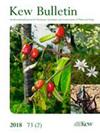Securidaca aurea(远志科,远志属),巴西亚马逊河流域的一个新物种
IF 0.9
4区 生物学
Q4 PLANT SCIENCES
引用次数: 0
摘要
在对所有泛热带地区的 Securidaca 属(远志科)进行审查期间,发现了一个亚马逊新种,在此描述为 S. aurea。新种与 S. revoluta 相比,主要是龙骨上没有嵴,叶片强烈外卷。然而,S. aurea 的翅果更长,叶片和枝条上覆盖着金色的毛被,因此很容易辨认。该新种配有照片插图,并提供了分类说明、初步保护状况和地理分布地图。本文章由计算机程序翻译,如有差异,请以英文原文为准。

Securidaca aurea (Polygalaceae, Polygaleae), a new species from the Brazilian Amazon
During a review of the genus Securidaca (Polygalaceae) in all pantropical regions, a new Amazonian species was found and is described here as S. aurea. The new species is compared to S. revoluta, mainly for the absence of the crest on the keel and strongly revolute leaves. However, S. aurea is easily recognised by its much longer samaras and the golden indumentum covering its leaves and branches. The new species is illustrated by photographic plates and taxonomic notes, a preliminary conservation status and a geographic distribution map are provided.
求助全文
通过发布文献求助,成功后即可免费获取论文全文。
去求助
来源期刊

Kew Bulletin
PLANT SCIENCES-
CiteScore
1.70
自引率
22.20%
发文量
71
期刊介绍:
Kew Bulletin is an international peer-reviewed journal for the taxonomy, systematics and conservation of vascular plants and fungi. Papers on conservation, evolution, palynology, cytology, anatomy, biogeography and phytochemistry are considered, where relevant to taxonomy and systematics. Review papers on topics appropriate to the journal are invited. The journal is richly illustrated with line drawings and photographs, and also features a Book Review and Notices section. Four parts (c. 640 pp) are published each year.
 求助内容:
求助内容: 应助结果提醒方式:
应助结果提醒方式:


